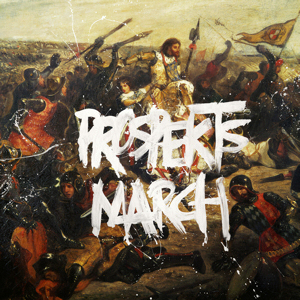Viva La Vida flows like a true album, to be heard in sequence. Ten tracks are listed, but many of them have distinct or even unlisted sections, showing off the variety and keeping the tedium at a minimum. It’s immediately more satisfying than X&Y, and remains so.
Floating in on a soothing loop, “Life In Technicolor” is something of a rousing overture before the darker, mysterious “Cemeteries Of London”. A brief piano piece provides a bridge to “Lost!”, heavy on organ and handclaps but still catchy. In other words, typical Coldplay, but not a retread. “42” is three songs in one, none of which seem to illuminate any kind of Douglas Adams reference. A “Scientist”-like opening section threatens to turn into one of their “big” numbers until giving way to a treated guitar section à la Radiohead, which turns into a more straightforward tune, then reverting to a variation on the opening part. But the feeling stays up on the driving “Lovers In Japan”, which shares its track with the much quieter “Reign Of Love”, treated very much in the manner of Eno.
The most exhilarating moment of the album is unlisted, but “Chinese Sleep Chant” is three minutes of shoe-gazing splendor with muffled vocals that reminds one of Echo and the Bunnymen. Because it arrives at the four-minute mark of “Yes”, children of the digital age will be forced to (gasp!) rewind. Despite its melodic similarity to too many songs from the history of composition, “Viva La Vida” still inspires, its combination of tympani, strings and hammer-on-church-bell providing the big single the band needed to sell the album. “Violet Hill” fades in on a Blue Nile hum, before crashing through topical verses at odds with their “if you love me” tags. A moment of studio verité sets up the lilting “Strawberry Swing”, processed guitar loops dominating tribal drums. Finally, “Death And All His Friends” moves from a quiet piano meditation to a more typical arena rocker, and ending with a lengthy version of the loop that began the album, another hidden song called “The Escapist”.
In true U2 style, there were leftovers, which were duly added to a re-release of the album by year’s end. However, in a nice gesture to those who didn’t want to buy the whole thing again, Prospekt's March was made available as a separate, attractively priced EP. More of a supplement than a side three, it underscores how wise they were to make Viva La Vida as compact as it is.
“Life In Technicolor II” appears with lyrics, including the omnipresent phrase “now my feet won’t touch the ground”, which is also the title of the EP’s acoustic closer. “Postcards From Far Away” is 45 seconds of piano (oddly not shoehorned within another track), giving way to the more mainstream “Glass Of Water” and “Rainy Day”, both redeemed by their choruses and tricky rhythms. Somewhat lost in all the energy is the title track, a pretty song tagged at the end with a piece called “Poppyfields”. Two of the tracks are retreads: “Lovers In Japan” is remixed without the “Reign Of Love” section, while “Lost+” answers the prayers of those who thought the album track needed a Jay-Z rap to make it truly exceptional. (For the rest of us, it’s a harbinger of doom. A solo piano version, dubbed “Lost?”, closed the iTunes version of Viva La Vida, and would have been welcome here.)
Coldplay Viva La Vida Or Death And All His Friends (2008)—4
Coldplay Prospekt's March (2008)—3


:format(jpeg):mode_rgb():quality(90)/discogs-images/R-5766836-1402077721-3866.jpeg.jpg)



